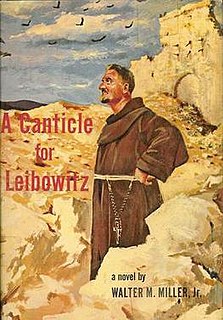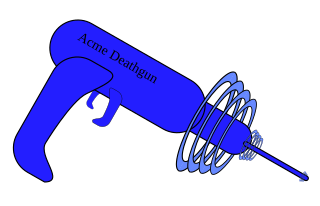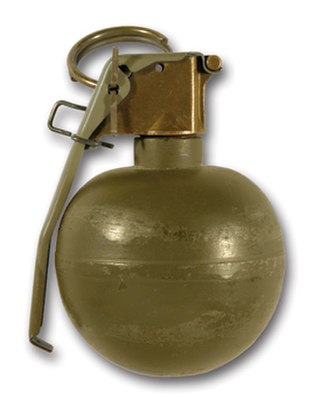External links
- Cease Fire title listing at the Internet Speculative Fiction Database
"Cease Fire" is a science fiction short story by Frank Herbert. It was first published in Astounding Science Fiction in 1958, and was included in the anthology of notable stories, A Century of Science Fiction (1962), edited by Damon Knight. It has also been published as part of later collections of Herbert's best stories, such as Eye .
The story is set in 1972, during a low level war against an unnamed enemy being waged somewhere in the arctic region of the American continent. Both sides have "life detection" technology, that can detect living creatures at a distance. The American side has an electromagnetic shield that can conceal people from the detectors.
Hulser is a scientist conscripted into the army. His wife is expecting their first child. He is manning a forward observation post using detectors and his own shield to spot enemy activity. His detector registers small life forms that may or may not be foxes or wolves. Hulser wonders if the enemy has a shield that merely reduces the apparent size of the person wearing it in the detector. Thinking about his own shield, and need to protect him against chemical reactions it would induce in his body, he realizes that the technology can be used to remotely detonate explosives, giving his side an overwhelming advantage and ending the war. Deciding that the detector is registering enemy soldiers, he calls in a mortar strike and then is embroiled in a full-scale fire fight. Panicking, he spends the rest of his time demanding to be pulled out.
The story describes Hulser's efforts to get out of combat and have his idea taken seriously. Convinced of his cause, he stands up to his sergeant and bullies his commanding officer, earning him a cell in the brig. There he is contacted by a prominent scientist who starts to believe his idea.
Eventually there is a successful demonstration attended by top military officers and a mysterious civilian that they defer to. Although the war will be won, they are strangely pessimistic. In the final scene they explain that although war with explosives is no longer possible, war will continue with even worse weapons, such as chemical poisons and disease agents. They give Hulser a copy of a book, saying that he and his children will need it. It is a copy of the unexpurgated works of "the master of treachery and deceit", Niccolò Machiavelli.

Franklin Patrick Herbert Jr. was an American science-fiction author best known for the 1965 novel Dune and its five sequels. Though he became famous for his novels, he also wrote short stories and worked as a newspaper journalist, photographer, book reviewer, ecological consultant, and lecturer.

A land mine is an explosive device concealed under or on the ground and designed to destroy or disable enemy targets, ranging from combatants to vehicles and tanks, as they pass over or near it. Such a device is typically detonated automatically by way of pressure when a target steps on it or drives over it, although other detonation mechanisms are also sometimes used. A land mine may cause damage by direct blast effect, by fragments that are thrown by the blast, or by both.

Poul William Anderson was an American science fiction author who began his career in the 1940s and continued to write into the 21st century. Anderson authored several works of fantasy, historical novels, and short stories. His awards include seven Hugo Awards and three Nebula Awards.

The Strategic Defense Initiative (SDI), nicknamed the "Star Wars program", was a proposed missile defense system intended to protect the United States from attack by ballistic strategic nuclear weapons. The concept was first announced on March 23, 1983 by President Ronald Reagan, a vocal critic of the doctrine of mutually assured destruction (MAD), which he described as a "suicide pact", and called upon American scientists and engineers to develop a system that would render nuclear weapons obsolete.
The Star Trek fictional universe contains a variety of weapons, ranging from missiles to melee. The Star Trek franchise consists primarily of several multi-season television shows and a dozen movies, as well as various video games and inspired merchandise. Many aspects of the fictional universe impact modern popular culture, especially the lingo and the idea of a spacecraft launching space torpedoes and firing lasers, and have had a wide influence in the late 20th to early 21st century. Star Trek is popular enough that its science fiction concepts have even been studied by real scientists, and NASA described its science in relation to the real world as "entertaining combination of real science, imaginary science gathered from lots of earlier stories, and stuff the writers make up week-by-week to give each new episode novelty." For example, NASA noted that the Star Trek "phasers" were a fictional extrapolation of real-life lasers, and compared them to real-life microwave based weapons that have a stunning effect.

A Canticle for Leibowitz is a post-apocalyptic science fiction novel by American writer Walter M. Miller Jr., first published in 1959. Set in a Catholic monastery in the desert of the southwestern United States after a devastating nuclear war, the book spans thousands of years as civilization rebuilds itself. The monks of the Albertian Order of Leibowitz preserve the surviving remnants of man's scientific knowledge until the world is again ready for it.
In speculative fiction, a force field, sometimes known as an energy shield, force shield, force bubble, defence shield or deflector shield, is a barrier made of things like energy, negative energy, dark energy, electromagnetic fields, gravitational fields, electric fields, quantum fields, plasma, particles, radiation, solid light, or pure force. It protects a person, area, or object from attacks or intrusions or even deflects energy attacks back at the attacker. This fictional technology is created as a field of energy without mass that acts as a wall, so that objects affected by the particular force relating to the field are unable to pass through the field and reach the other side, are deflected or destroyed. This concept has become a staple of many science-fiction works, so much that authors frequently do not even bother to explain or justify them to their readers, treating them almost as established fact and attributing whatever capabilities the plot requires.

Strange and exotic weapons are a recurring feature in science fiction. In some cases, weapons first introduced in science fiction have been made a reality; other science fiction weapons remain purely fictional, and are often beyond the realms of known physical possibility.

The Cone of Silence is one of many recurring joke devices from Get Smart, a 1960s American comedy television series about an inept spy. The essence of the joke is that the apparatus, designed for secret conversations, makes it impossible for those inside the device – and easy for those outside the device – to hear the conversation.

Muhammed Zafar Iqbal is a Bangladeshi science fiction author, physicist, academic and activist. He is a professor of computer science and engineering at Shahjalal University of Science and Technology (SUST). As of January 2018, he is the head of Electrical and Electronic Engineering department. He achieved his PhD from University of Washington. After working long 18 years as a Scientist in California Institute of Technology and Bel Communications Research, he returned to his own motherland Bangladesh and joined Shahjalal University of Science and Technology as a professor of Computer Science and Engineering.
The exploration of politics in science fiction is arguably older than the identification of the genre. One of the earliest works of modern science fiction, H. G. Wells’ The Time Machine, is an extrapolation of the class structure of the United Kingdom of his time, an extreme form of Social Darwinism; during tens of thousands of years, human beings have evolved into two different species based on their social class.

Demining or mine clearance is the process of removing land mines from an area. In military operations, the object is to rapidly clear a path through a minefield, and this is often done with devices such as mine plows and blast waves. By contrast, the goal of humanitarian demining is to remove all of the landmines to a given depth and make the land safe for human use. Specially trained dogs are also used to narrow down the search and verify that an area is cleared. Mechanical devices such as flails and excavators are sometimes used to clear mines.

Stargate Worlds was to be a massively multiplayer online role-playing game (MMORPG) video game, but it was put on hold and never released. It was developed by Cheyenne Mountain Entertainment (CME) in association with Metro-Goldwyn-Mayer (MGM) and would have been published by FireSky for Microsoft Windows. The game's setting was based on the military science fiction series Stargate SG-1. The game was to focus on a premise set around an ancient device called the "Stargate".

Technology in science fiction examines the possibilities and implications of new technological concepts. Authors have taken, or created, new innovations and technologies, and elaborated on what they might be and how they might be used. This exchange goes in both directions – sometimes the technology appears first in science fiction, then becomes reality and other times the real technology comes first, and science fiction authors speculate about how it might be used, and how it might affect the human condition. Likewise, the accuracy of the technology portrayed spans a wide range – sometimes it is existing technology, sometimes it is a physically realistic portrayal of a far-out technology, and sometimes it is simply a plot device that looks scientific, but has no basis in science. Examples drawn from space travel in science fiction include:

The Huolongjing, also known as Huoqitu, is a 14th-century military treatise compiled and edited by Jiao Yu and Liu Bowen of the early Ming dynasty (1368–1683). The Huolongjing is primarily based on the text known as Huolong Shenqi Tufa, which is no longer extant.

Triplanetary is a science fiction novel and space opera by American writer E. E. Smith. It was first serialized in the magazine Amazing Stories in 1934. After the original four novels of the Lensman series were published, Smith expanded and reworked Triplanetary into the first of two prequels for the series. The expanded Triplanetary was published in book form in 1948 by Fantasy Press. The second prequel, First Lensman, was a new original novel published in 1950 by Fantasy Press.

A grenade is an explosive weapon typically thrown by hand, but can also refer to a shell shot out by a rifle or a grenade launcher. A modern hand grenade generally consists of an explosive charge ("filler"), a detonator mechanism, an internal striker to trigger the detonator, and a safety lever secured by a linchpin. The user pulls the safety pin before throwing, and once thrown the safety lever gets released, allowing the striker to trigger a primer that ignites a fuze, which burns down to the detonator and explodes the main charge.

The U.S. Army Edgewood Chemical Biological Center (ECBC) is the United States’s principal research and development resource for non-medical chemical and biological (CB) defense. As a critical national asset in the CB defense community, ECBC supports all phases of the acquisition life-cycle ― from basic and applied research through technology development, engineering design, equipment evaluation, product support, sustainment, field operations and demilitarization ― to address its customers’ unique requirements.

The War of the Worlds is a science fiction novel by English author H. G. Wells, first serialised in 1897 by Pearson's Magazine in the UK and by Cosmopolitan magazine in the US. The novel's first appearance in hardcover was in 1898 from publisher William Heinemann of London. Written between 1895 and 1897, it is one of the earliest stories to detail a conflict between mankind and an extra-terrestrial race. The novel is the first-person narrative of both an unnamed protagonist in Surrey and of his younger brother in London as southern England is invaded by Martians. The novel is one of the most commented-on works in the science fiction canon.